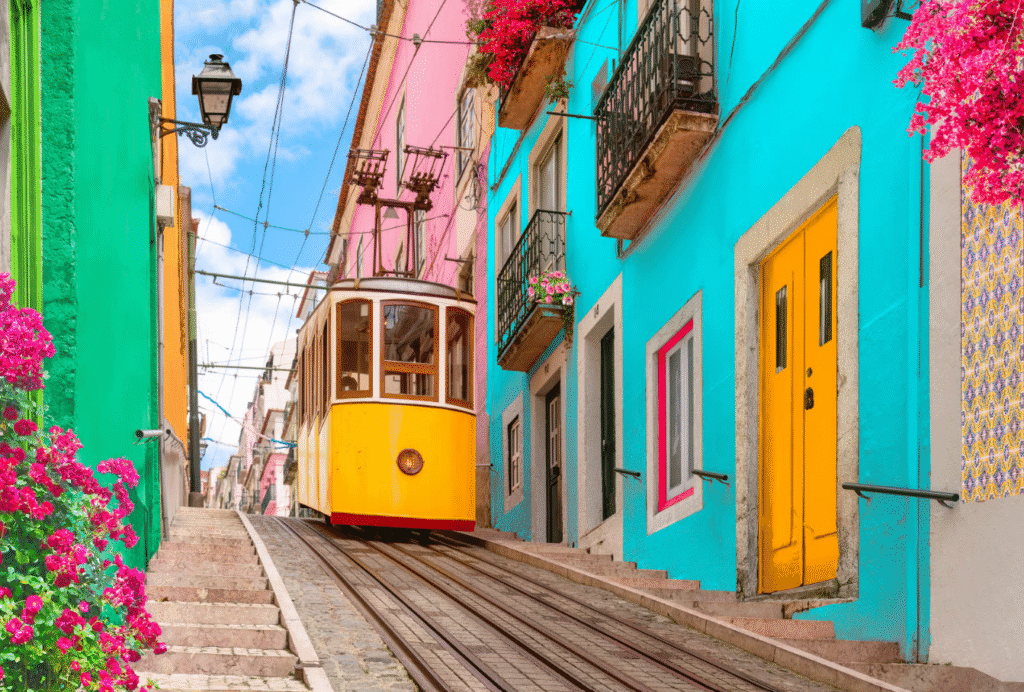Portugal has a way of feeling both familiar and surprising at once. You’ll notice it in the small details, tiled walls catching the light, cafés that serve espresso like it’s a ritual, and the sea always somewhere close.
It’s a country that doesn’t shout for attention; it unfolds slowly as you wander. One day you’re tracing narrow lanes in Lisbon, the next you’re tasting wine in the Douro or walking along cliffs in the Algarve. It’s varied without being overwhelming, and that’s what makes travelling here so easy to enjoy.
Lisbon: Steep Streets and Easy Charm

Lisbon’s rhythm is unhurried but never dull. The city climbs and falls across seven hills, so you’ll find yourself catching your breath as much as staring out at the view. Alfama hums with fado at night, while Bairro Alto gets louder as bars spill onto the streets.
Mornings often start with pastel de nata and coffee at a standing counter. Trams rattle through, packed with both commuters and curious travelers, and sometimes you’ll see washing strung above your head between buildings painted in faded yellows and pinks.
It’s best explored on foot, even if you lose your sense of direction. Down by the river, people sit with cans of beer watching the bridge glow red at sunset. Lisbon feels lived-in, slightly frayed at the edges, and that’s exactly its appeal, it doesn’t pretend to be anything other than what it is.
Related – 9 Best Hotels in Portugal – Enchanting Hotels That Will Wow You!
Porto: River Views and a Slower Beat
Further north, Porto feels older and more grounded. The Douro River cuts through the centre, and from almost anywhere you can see its curve. Ribeira’s riverfront is where most people end up, there are cafés, wine bars, boats coming and going, but the real heart of Porto is a few streets back.
Small grocery shops sell fresh sardines next to wine merchants who still measure from the barrel. There’s a kind of quiet pride here, less polished than Lisbon but no less interesting. Walk across Dom Luís I Bridge for the view, then cross back after dark when the city lights shimmer on the water.
Port cellars sit waiting across in Vila Nova de Gaia, and tasting one inside the cool stone tunnels is part of the fabric of being here. It’s not a city that tries to entertain you, it just carries on, and invites you to join in.
The Algarve: Wild Coast and Restless Light
The Algarve is often described by its beaches, but that barely scratches the surface. West of Lagos, the cliffs turn rugged and the wind feels stronger, especially around Sagres where the Atlantic pushes hard.
You can drive for hours between coves and not see the same stretch of coast twice. Inland, the mood changes, quiet villages, almond trees, whitewashed walls. The local pace slows everything down, and even the joy of finding lunch becomes part of the itinerary for the day. You’ll find seafood that’s simply grilled, no decoration needed.
In summer it gets crowded near Albufeira or Vilamoura, but small towns like Tavira or Salema still hold onto their calm. The light shifts constantly here; it’s bright, then soft, then golden just before dusk. The Algarve isn’t just a beach holiday, it’s a patchwork of sea, salt, and space, the kind that clears your head without you even noticing.
Tours and Trails: For When One Destination is not Enough
If you can’t decide where to go in Portugal, a tour can help you see more without feeling rushed.
You might start with a private guided tour of Porto, then spend a day in the Douro Valley visiting a hillside winery before drifting back to the riverfront. In Lisbon, guides take you through Alfama’s food stalls, out to Sintra’s palaces, or even as far as Évora and the quiet lanes of the Alentejo. Down south, a private sailing trip along the Algarve’s coast gives you time to stop at coves you’d never reach alone, with long breaks for swimming or a glass of wine.
Some of these are full-on luxury Portugal travel experiences, others are simple and flexible. Either way, they link the country together, coast, city, and countryside, so you don’t have to choose just one.
Beyond the Mainland: The Islands that Keep Their Secrets
Portugal’s islands feel like another chapter. The Azores sit far out in the Atlantic, volcanic and green, where cows graze beside crater lakes and roads curve through clouds.
São Miguel has the most going on, thermal pools, tiny harbours, and tea plantations that smell faintly of sea air. It’s wild but never unkind. Madeira, further south, feels more cultivated but still remote enough to stay peaceful.
You can walk its levadas, old irrigation paths that wind through forests and open suddenly to sea cliffs. Funchal’s markets hum with chatter and the scent of ripe fruit, but step a little away and it’s all quiet again. Both islands are a reminder that Portugal’s story isn’t just coastal towns and tiled cities; it’s also about places that sit far off the mainland, holding on to their own slow rhythm.
Why Does Portugal Stay With You?
It’s not the postcard scenes that make Portugal memorable. It’s the small, ordinary things like the sound of footsteps on cobblestones, a plate of grilled fish you didn’t expect much from, and the way strangers talk like they’ve known you for years.
You travel through the country thinking you understand it, but you keep learning as you go about the pace, the light, and the language of the land. Portugal doesn’t try to impress. It just lets you find your own way in, and that’s enough.






